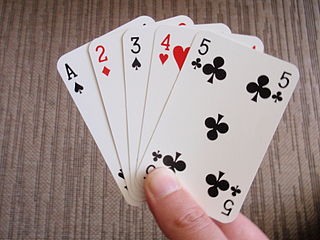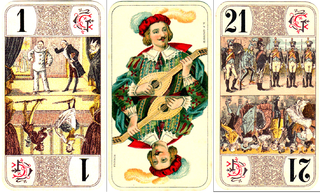Related Research Articles

A playing card is a piece of specially prepared card stock, heavy paper, thin cardboard, plastic-coated paper, cotton-paper blend, or thin plastic that is marked with distinguishing motifs. Often the front (face) and back of each card has a finish to make handling easier. They are most commonly used for playing card games, and are also used in magic tricks, cardistry, card throwing, and card houses; cards may also be collected. Playing cards are typically palm-sized for convenient handling, and usually are sold together in a set as a deck of cards or pack of cards.

The United States Playing Card Company is a large American producer and distributor of playing cards. It was established in 1867 as Russell, Morgan & Co. and founded in its current incarnation in 1885. Its many brands include Bicycle, Bee, Tally-Ho, Champion, Congress, Aviator, Aristocrat, Mohawk, Maverick, KEM, Hoyle and Fournier. It also produces novelty and custom playing cards, and other playing card accessories such as poker chips. For decades the company was based in Norwood, Ohio, but as of 2009, the USPC is currently headquartered in the Cincinnati suburb of Erlanger, Kentucky.

Spanish-suited playing cards or Spanish-suited cards have four suits, and a deck is usually made up of 40 or 48 cards. It is categorized as a Latin-suited deck and has strong similarities with the Portuguese-suited deck, Italian-suited deck and some to the French deck. Spanish-suited cards are used in Spain, southern Italy, parts of France, Hispanic America, North Africa, and the Philippines.
Cartamundi Group is a company based in Turnhout, Belgium, that manufactures, produces, and sells board games, card games, collectible card games, packages, and playing cards through its manufacturing and sales subsidiaries. The name of the company in Latin means cards for the world. It is one of the world's largest playing card manufacturers.

Naipes Heraclio Fournier S.A. is a well known Spanish playing card manufacturer based in Vitoria and which has its factory in Legutio (Spain). This company is property of the United States Playing Card Company, which is a subsidiary of the Turnhout, Belgium–based Cartamundi.

Troggu is a member of the tarot family of card games. Synonyms for the game's name are: Trogga, Tappu and Tappä. It is played in the area of Visp, Switzerland, in Upper Wallis, especially in St. Niklaus and Grächen. After Troccas, it is the second most played tarot card game in Switzerland.

The Bourgeois Tarot deck is a mid-19th century pattern of tarot cards of German origin that is still used for playing card games today in western Europe and Canada. It is not designed for divinatory purposes. This deck is most commonly found in France, Belgian Wallonia, Swiss Romandy and Canadian Québec for playing French Tarot; in southwest Germany for playing Cego and Dreierles; and in Denmark for Danish Tarok.
The Tarocco Piemontese is a type of tarot deck of Italian origin. It is the most common tarot playing set in northern Italy, much more common than the Tarocco Bolognese. The most popular Piedmontese tarot games are Scarto, Mitigati, Chiamare il Re, and Partita which are played in Pinerolo and Turin. This deck is considered part of Piedmontese culture and appeared in the 2006 Winter Olympics closing ceremony held in Turin. As this was the standard tarot pack of the Kingdom of Sardinia, it was also formerly used in Savoy and Nice before their annexation by France. Additionally, it was used as an alternative to the Tarocco Siciliano in Calatafimi-Segesta, Sicily. Outside of Italy, it is used by a small number of players in Ticino, Switzerland and was used by Italian Argentines.

Rams is a European trick-taking card game related to Nap and Loo, and may be played by any number of persons not exceeding nine, although five or seven make a good game. In Belgium and France, the game of Rams is also spelt Rammes or Rems, in Germany, Rams, Rammes, Ramsch, Ramschen, Ramscheln or Ramsen, in Austria, Ramsen and Ramschen, and, in America, Rounce. The basic idea is fairly constant, but scoring systems vary. It was a widespread European gambling and drinking game that is still popular today. During the 19th century, it was introduced as Rounce in America and played with a 52-card deck without any difference between simples and doubles and with no General Rounce announcement. In the modern German variety of the game, Ramscheln, the 7♦ is the second best trump ranking next below the ace.
Jeu Royal de la Guerre is a French novelty card game for two to twelve players that was described in La Maison des Jeux Academiques in 1659. It is a trick-taking game played with a dedicated war-themed 40-card pack based on the French-suited 36-card piquet pack. The suits are irrelevant for gameplay, and to a large extent the game is determined by four suitless special cards.

Aluette or Vache ("Cow") is an old, plain trick-taking card game that is played on the west coast of France. It is played by two teams, usually of four people, but sometimes also of six. It is unusual in using a unique pack of 48 Spanish playing cards and a system of signalling between playing partners. The French colloquial names for the game, jeu de la Vache or Vache, refer to the cow depicted on one of the cards.

ASS Altenburger is since 2003 the trademark of the German playing card manufacturer Spielkartenfabrik Altenburg, based in the town of Altenburg. The firm is owned by Cartamundi, of Turnhout, Belgium. ASS claims to be the market leader in Germany for playing cards. Every year almost 40 million packs of cards of many different types are manufactured in Altenburg.

The Tarot de Besançon, also called the Besançon Tarot, describes a type of Tarot pack for card games that was derived from the older forms of the Marseille type, but which portrays characteristic differences. The Swiss Tarot pattern was derived from it.

The game of Nain Jaune or Yellow Dwarf, also formerly called Lindor, is an "attractive and unique traditional French card game" using a board comprising five compartments or boxes. It is a reasoned game of chance because it combines the hazards of card distribution with the strategy of building suits. Nain Jaune, which is considered a classic French game, is named after the seven of diamonds, which is depicted as a yellow dwarf in the centre of the game board.
Thierry Depaulis is an independent historian of games and especially of playing cards, card games, and board games. He is President of the association Le Vieux Papier, a member of the editorial board of the International Board Game Studies Association, and a member of the board of directors of the foundation of the Swiss Museum of Games. He was President of the International Playing-Card Society from 2017 to 2022.
France Cartes Cartamundi is a manufacturer of playing cards and games that is based in France at Saint-Max. The company introduced the Ducale brand of playing cards in 1946 and became the largest playing card manufacturer in France in 1962 after acquiring their competitor, Grimaud. Other brands marketed by France Cartes include Shuffle, Carta Magic, Grimaud Cartomancie, and Éditions Dusserre. France Cartes was acquired by Cartamundi in 2014.

Coucou ("Cuckoo") is an historical French card game that uses a pack of 32 or 52 cards and is played by five to twenty players. It is unusual for being played with only a single card in hand. As a shedding game, there is only one winner who may claim the stakes, if there are any. The game has also been called As Qui Court or Hère.

Culbas or Cul-bas is an historical French card game of the fishing type for three to eight players that dates to at least the 17th century. It is described as being "very old" and having "a great simplicity in which chance plays the biggest role."

Papillon is an old French card game of the fishing type for three or four players. It has been described as "perfect for children who know how to count".

The Cartes de Suisses were a 18th century standard pattern of Tarot playing cards that were initially produced in Switzerland, but later in the Austrian Netherlands, now part of Belgium. As a result they are also referred to as the Flemish Tarot or the Belgian Tarot.